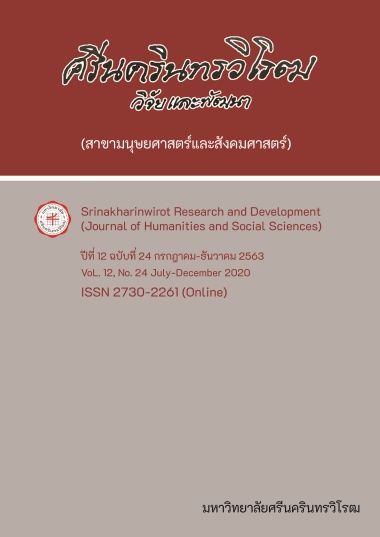ความสัมพันธ์ระหว่างปัจจัยด้านอุปกรณ์เครื่องใช้ไฟฟ้ากับค่าไฟฟ้าของครัวเรือน ในประเทศไทย THE RELATIONSHIP BETWEEN APPLIANCE FACTOR AND HOUSEHOLD ELECTRICITY EXPENDITURE IN THAILAND
Keywords:
Appliances, Household Electricity Expenditure, Appliance FactorsAbstract
In this study, the main objective was to find out the relationship between the appliance factor and the household electricity expenditure. Secondary data from the “2017 Household Socio-Economic Survey” complied by the National Statistical Office were employed to this study. Regarding this work, the dependent variable was the monthly household electricity expenditure and the independent variables were appliance factor, including 9 categories of the electricity appliances and the household socio-economic factors, which were gender age-groups and level of education of household head. In addition, other household characteristics were also applied to this study, including number of household member, household income, area of residences, number of room, and types of residence. Generalized Least Square (GLS) method was adopted to this study to estimate the relationship between the dependent variable and the independent variables. From obtained results showed that, when other thing being equal, there was a positive relationship between number of the electricity appliances that household occupied and the household monthly electricity expenditure, the more electricity that household occupied, the more monthly electricity expenditure. Except, household whose occupied to the laundry appliances, there was a negative relationship between number of laundry appliances and the household monthly electricity expenditure. Furthermore, the results also showed that, when other thing being equal, an increase of the air-conditioner appliance, household had a highest marginal cost of electricity, followed by the water heater, the electricity water pump, and the computer devices.
Downloads
References
[2] จารุพัสตร์ พิชิตานนท์. (2549). ค่าใช้จ่ายด้านพลังงานของครัวเรือนไทย. วิทยานิพนธ์ปริญญามหาบัณฑิต (เศรษฐศาสตร์). บัณฑิตวิทยาลัย จุฬาลงกรณ์มหาวิทยาลัย.
[3] Choiejit., R., & Teungfung., R. (2013). Energy Consumption of Thai Elderly Households. Journal of Economics and Public policy, 5, 1-15.
[4] Jones, R., & Lomas, K. (2015). Determinants of high electricity energy demand in UK homes: Socio-economics and dwelling characteristics. Energy and Building, 101, 24-34.
[5] Zhou, S., & Teng, F. (2013). Estimating of urban residential electricity demand in China using household survey data. Energy Policy, 61, 394-402.
[6] Huebner, G., Hamilton, I., Chalabi, Z., Shipworth, D., & Oreszczyn, T. (2015). Explaining domestic energy consumption-the comparative contribution of building factors, socio-demographics, behaviors and attitudes. Applied Energy, 159, 589-600.
[7] Leahy, E., & Lyons, S. (2010). Energy use and appliance ownership in Ireland. Energy Policy, 38(8), 4265-4279.
[8] Huebner, G., Shipworth, D., Hamilton, I., Chalabi, Z., & Oreszczyn, T. (2016). Understanding Electricity consumption : A comparative contribution of building factors, socio-demographics, appliances, behaviors and attitudes. Applied Energy, 177, 692-702.
[9] Yohanis, Y., Mondol, J., Wright, A., & Norton, B. (2008). Real-life energy use in the UK: howoccupancy and dwelling characteristics affect domestic electricity use. Energy and Building, 40(6), 1053-1059.
[10] Esmaeilimonakher, P., Urmee, T., Pryor, T., & Baverstock, G. (2016). Identifying the determinants of residential electricity consumption for social housing in Perth, Western Australia. Energy and Buildings, 133, 403-413.
[11] Brounen, D., Kok, N., & Quigley, J. (2012). Residential energy use and conservation: Economics and demographics. European Economic Review, 56(5), 931- 945.
[12] Wiesmann, D., Azevedo, I., Ferrao, P., & Fernandez, J. (2011). Residential electricity consumption in Portugal: Finding from top-down and bottom-up models. Energy Policy, 39(5), 2772-2779.
[13] McLoughlin, F., Duffy, A., & Conlon, M. (2012). Characterizing domestic electricity consumption patterns by dwelling and occupant socio-economic variables:
An Irish case study. Energy and Buildings, 48, 240-248.
[14] Yalcintas, M., & Kay, A. (2017). Roles of income, price and household size on residential electricity consumption: Comparison of Hawaii with similar climate zone states. Energy Reports, 3, 109-118.
[15] Bedir, M., Hasselaar, E., & Itard, L. (2013). Determinants of electricity consumption in Dutch Dwellings. Energy and Buildings, 58, 194-207.
[16] Sanquist, T., Orr, H., Shui, B., & Bittner, A., (2012). Lifestyle factors in U.S. residential electricity consumption. Energy Policy, 42, 354-364.
[17] Wyatt, P. (2013). A dwelling-level investigation into the physical and socio-economic driver of domestic energy consumption in England. Energy Policy, 60, 540-549.
[18] Damodar, N. Gujarati.,& Dawn, C. Porter. (2009). Basic econometrics. McGraw-Hill Irwin, Boston.
[19] ปฏิภาณ ภมรสูตร. (2549). พฤติกรรมการใช้บริการเครื่องซักผ้าหยอดเหรียญของผู้ใช้บริการในอำเภอเมือง จังหวัดเชียงใหม่. วิทยานิพนธ์ปริญญามหาบัณฑิต (การบริหารธุรกิจ) มหาวิทยาลัยเชียงใหม่.
[20] ลออรัตน์ สุขสุแพทย์. (2561). ปัจจัยที่มีอิทธิพลต่อพฤติกรรมการใช้บริการเครื่องซักผ้าหยอดเหรียญของบริษัทเค-เน็กซ์ คอร์ปอเรชั่น จำกัด ภายใต้แบรนด์ “อ๊อตเทริ วอช แอนด์ ดราย”
(Otteri wash and dry) ของผู้บริโภคในเขตกรุงเทพมหานคร. บทความวิชาการค้นคว้าอิสระ คณะบริหารธุรกิจ มหาวิทยาลัยรามคำแหง. สืบค้นจาก http://www.ba-abstract.ru.ac.th/index.php/abstractData/viewIndex/43.ru
Downloads
Published
How to Cite
Issue
Section
License
Srinakharinwirot Research and Development Journal of Humanities and Social Sciences is licensed Under a Creative Commons Attribution-NonCommercial-NoDerivs 4.0 International (CC-BY-NC-ND 4.0) License, Unless Otherwise Stated. Please Read Journal Policies Page for More Information on Open Access, Copyright and Permissions.



